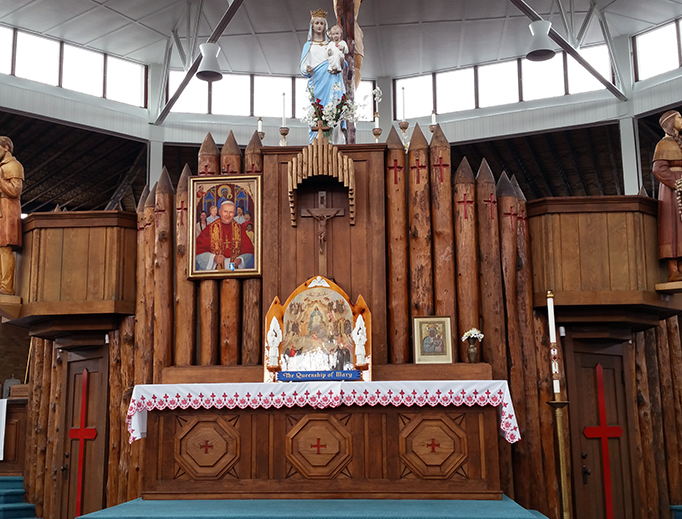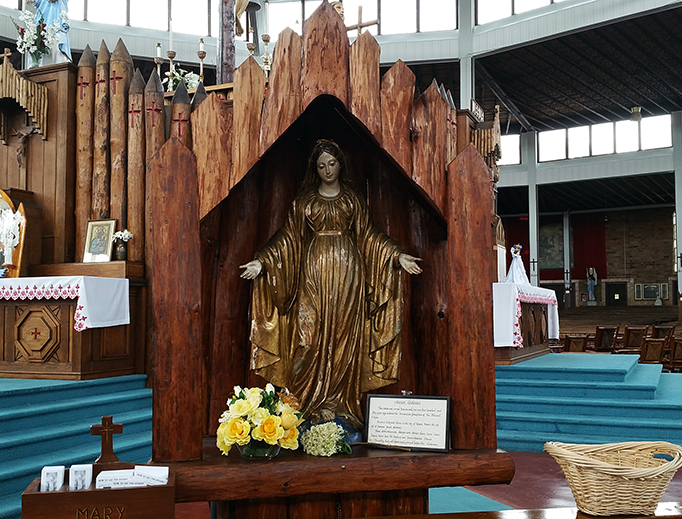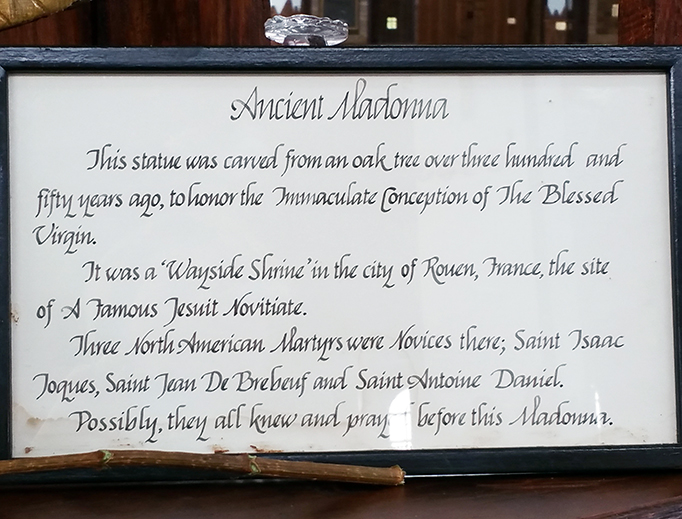A Visit to the Shrine of Our Lady of the Martyrs in Auriesville, New York
I’ve prayed before many reliquaries in my life, but never have I prayed upon one.

It’s one thing to read about martyrs. It’s another thing to walk the ground upon which they shed their blood.
The Shrine of Our Lady of the Martyrs in Auriesville, New York, is my most recent stop on my Marian Pilgrimage across the United States. The shrine is built on the site of the Mohawk village of Ossernenon and marks the place of martyrdom of three of the eight North American Martyrs: Father Isaac Jogues and his two lay companions, René Goupil and John LaLande. They were martyred in the 1640s, along with five Jesuit priests martyred in Canada. It’s also believed to be the 1656 birthplace of Saint Kateri Tekakwitha.
French Jesuits came to Canada in 1625, led by Father John de Brébeuf, who became one of the North American Martyrs. They traveled the regions of Lake Huron to evangelize the Huron tribe. In 1636, Father Isaac Jogues joined him. In 1642, he embarked on an 800-mile journey along the French River, Ottawa River, and finally the St. Lawrence River toward what is now New York State. With frequent Iroquois raids along the St. Lawrence, the trip was dangerous on many levels.
While traveling, Father Jogues met René Goupil, who aspired to become a Jesuit priest but was held back by his deafness. He instead became a lay Jesuit and served in his capacity as physician and surgeon to those in need. Another Jesuit layman, William Couture, and a young Catholic Huron girl named Theresa accompanied them. They were ambushed by Iroquois and captured. Over a two-week period, they were taken by canoe and on foot to the Mohawk Valley, stopping at various Iroquois villages along the way where they were further brutalized. In the interim, Goupil asked to profess his vows. Father Jogues accepted his request and blessed him as a Brother in the Society of Jesus.
The suffering they endured is unspeakable – running the gauntlet, burning, torture, mutilation, and more. Several of Father Jogues’ fingers were severed, including his index fingers and thumbs – those used by the priest to hold the consecrated Host at Mass. They somehow survived the brutality. Couture and Theresa were taken to another village but Father Jogues and Goupil remained at Ossernenon where they were kept as slaves and experienced further torture regularly.
One day, Goupil was caught making the Sign of the Cross over a Mohawk child, angering the boy’s grandfather who ordered his death. Days later, as Goupil and Father Jogues prayed the Rosary together – the first recitation of the Rosary documented in New York state – a Mohawk brave killed Goupil with a tomahawk.
His body was dumped into a nearby Ravine, where it was prey to wild animals. Father Jogues later found the ravaged body of his dear friend. and used rocks to submerge it in a nearby creek for later burial. Flooding carried the body away. The next spring, Father Jogues was able to find Goupil’s skull and a few of his bones and buried them in the Ravine. The exact place of Goupil’s grave has never been discovered and so the entire Ravine is now a reliquary of his remains.
With the help of the Dutch, Father Jogues escaped his captors in 1643 and returned to France. Still passionate for the conversion of the Mohawks, he returned to Canada four months later and two years after that to Ossernenon. This time, he was accompanied by another lay Jesuit, John LaLande. It a tragic twist of events, the missionaries were blamed for illness and crop failure that had devastated the Mohawk Valley. The two were captured, tortured, murdered, and beheaded. Their heads were placed on the village palisades as a warning to the French.
This is the backdrop for my visit to the Shrine of Our Lady of the Martyrs.
The shrine was founded in 1884 by Jesuit Father Joseph Loyzance on ten-acre plot of land with a simple shrine dedicated to Our Lady of the Martyrs. The current shrine was built in 1930 and in the shape of a coliseum – the first circular church in the United States. Seating 6,000, it’s open from early April to October 19 (feast of the North American Martyrs) for visitors, weekly Masses, and a wide range of special religious events and celebrations. Today, the land spans 600 acres and includes a Stations of the Cross, meditation gardens and chapels for prayer as well as facilities for groups and an outstanding museum.
The grounds are both ominous and glorious. Mohawk longhouses and the platforms on which prisoners were shamed, burned, and mutilated once stood there. One can look down the steep hill descending to the Mohawk River – the same hill that Father Jogues and René Goupil, already beaten, maimed and weak, were made to ascend through a gauntlet of enraged, armed Mohawk warriors. Reverence, sadness, awe, and gratitude filled my heart. I prayed that, if faced with the same circumstances, I would be as courageous.
Across the road is the Ravine where Father Jogues buried René Goupil’s remains. The paved pathway leading down the hill is lined with placards telling Goupil’s incredible story. Each step leads one’s heart deeper into the reality of this man’s astounding sacrifice for the Faith. More pathways wind through and around the Ravine along which are statues and places of devotion, including a lovely outdoor Marian shrine at its center. There is silence, but for the muffled footsteps of pilgrims prayerfully wandering the sacred ground that has been soaked with the blood of martyrs.
I’ve prayed before many reliquaries in my life, but never have I prayed upon one. It’s a compelling, unforgettable experience that’s had a profound impact on my heart and on my faith.
For more on the Shrine of Our Lady of the Martyrs and its excellent museum, see MargeFenelon.com.
For more information and to plan your visit to the shrine, see http://www.auriesvilleshrine.com/.
















